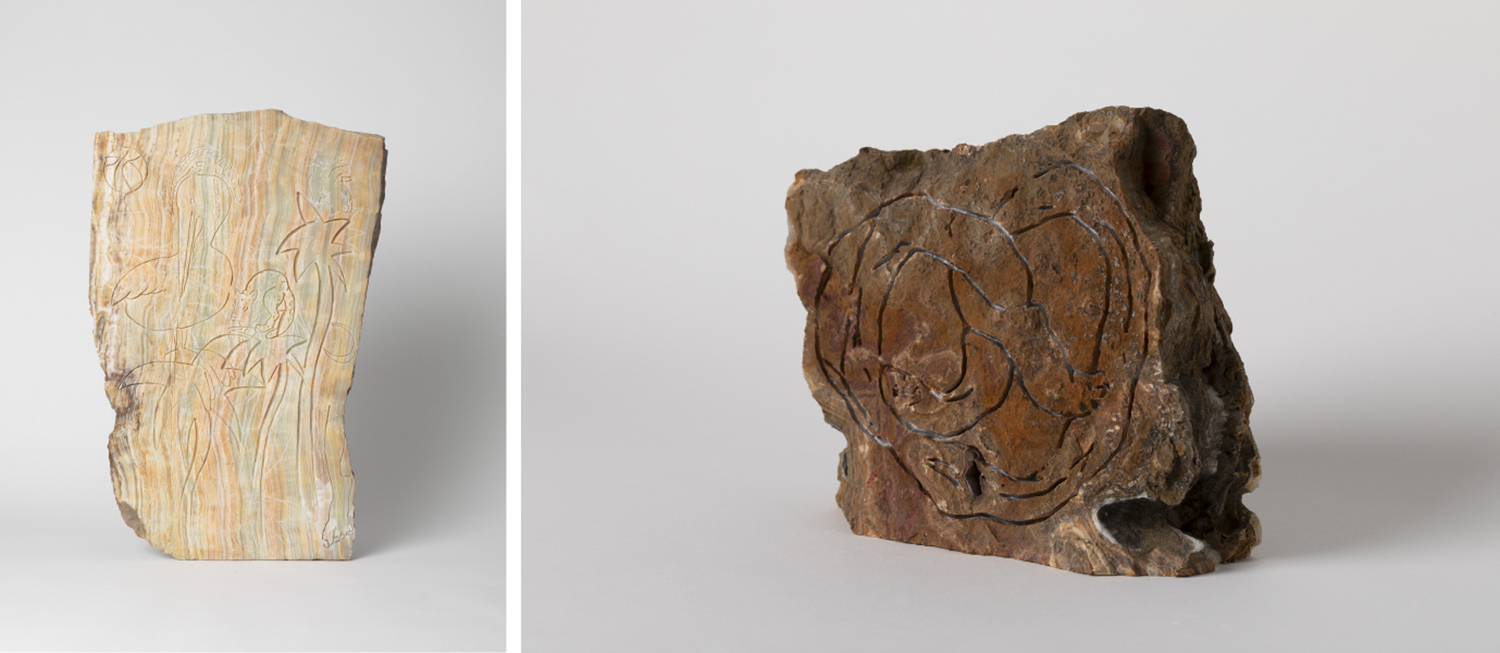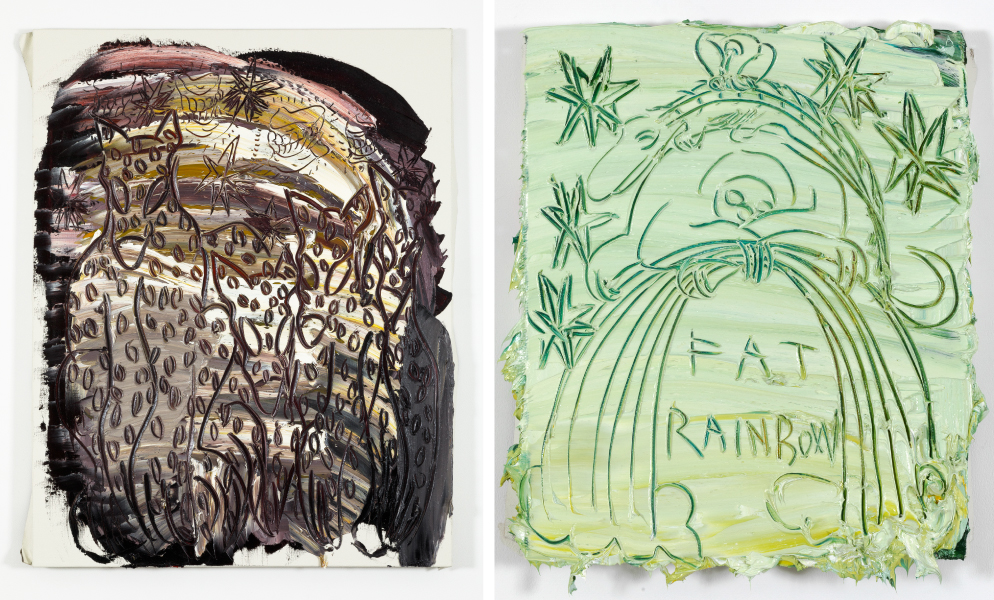WAITINGROOM (Tokyo) is pleased to present “Even the pigments in paints were once stones,” a solo exhibition by Rikako Kawauchi from November 25 (Sat) to December 24 (Sun), 2023. Kawauchi works with a wide variety of materials, including paintings, drawings, wire, and neon tubing, all centered on the fundamental theme of the body. In recent years, she has also become known for her colorful paintings of motifs such as animals and parts of the human body that appear symbolically in myths from various regions along the themes of digestion, excretion, and cooking.
At this exhibition, the artist will present a new series of works using marble and other stones as materials, along with a number of new paintings. Kawauchi’s works are characterized by the line that is articulated by her own body, regardless of the mode of artistic expression. In her oil paintings, Kawauchi does not paint the inside of objects surrounded by contours or outlines, but rather applies layers of thickly painted color to the surface with quick, scratch-like strokes. In her new series of stone sculptures, Kawauchi continues to build on the techniques used in her paintings, carving out her distinctive line drawings over the natural colors and patterns of marble. We hope that visitors will enjoy this new series that represents the artist’s encounter with her new materials.

left: “A Day in the Life” 2023, stone, 450 x 710 x 50 mm
right: “pretzel” 2023, stone, 220 x 220 x 70 mm
both photos by Shintaro Yamanaka (Qsyum!)
About the artist, Rikako Kawauchi
Born in Tokyo, Japan in 1990.Graduated from Tama Art University with the Master’s degree in 2017. Currently lives and works in Tokyo. Taking her interest in food as her starting point, her works are focused on the body and thought, self and others, the indistinctness of their boundaries, and the mythological world in which digestion, excretion, eating, and the body created from it are the starting points for the creation of the world. Her expressive methods range from drawing and painting to wire, rubber tubing, resin, neon tubes, and more. In 2014, while a student at Tama Art University, she received the Kenjiro Hosaka Award at the CAF ART AWARD 2014, a publicly-collected group exhibition, and in 2003 she received the SHISEIDO ART EGG Award (Grand Prize) at the Shiseido Art Egg, a program for up-and-coming artists. In 2009, she selected as a finalist for the “TERRADA ART AWARD 2021” and received the Yuki Terase Prize; in 2010, she received the VOCA Award, the grand prize, for the “VOCA Exhibition 2022: Prospects for Contemporary Art – New Artists on the Plane”. Recent exhibitions include “The Voice of Soul” (ERA GALLERY, Milan, Italy), “human closely” (Lurf MUSEUM, Tokyo), “lines & colors” (N&A Art SITE, Tokyo), and “Lines” (VAN DER GRINTEN GALLERY, Tokyo) in 2023. Lines” (VAN DER GRINTEN GALERIE, Cologne, Germany, 2010), and others. Her major collections include Aichi Prefectural Museum of Art, Aichi, Japan.
Artist Statement
For me, paint is akin to water.
I sometimes feel that water and earth can be found in the touch of paint.
It can feel like a waterfall, the ripples across a lake, the depth of the ocean, a cliff, layers of earth, or a fossil.
Just as the clouds and colors in the sky shift from one moment to another, the pigment found in the softness of a painting changes constantly as I paint.
At a certain point, the flow in the painting comes to feel as solid as a stone in my mind, and the pictorial image crystallizes.
How does a stone come to be?
The accumulation of instantaneous moments over a long period of time transforms into layers and strata of stone, giving rise to a harmony that is unintentionally beautiful.
I want this same sort of nature to exist in the paint, in my brushstrokes, and in the traces of my brush.
In the softness of the paint, I seek out nature, which gradually solidifies within the time that belongs to the pigment, and acquires the hardness of a stone.
The next time around, I would like to try to discover the gentle, pliable lines that exist in the hardness of the stone.
When I draw lines on stone, the stone takes on the feel of some kind of lumpen mass — as if the paint itself had been taken out of the canvas.
When I think about it, however, I realize that pigment is also made by scraping off something that resides within nature, such as a stone, and combining it with water or oil.
Paints and pigments used to be stones, too.
Perhaps that’s why whenever I find soft and gentle lines in stone, I have the feeling that the surface of the stone has also regained a skin-like softness.
(Rikako Kawauchi)

left: “gather at the riverbank”, 2023, oil on canvas, 1167 x 910 mm
right: “FAT RAINBOW”, 2023, oil on canvas, 455 x 380 mm
Soft lines that fix fluctuations in place
For Rikako Kawauchi, who began her career with an exhibition consisting solely of drawings that left a strong impact on the viewer, the line is that which most directly expresses the physicality of the person drawing it. “I believe that a line expresses the movement of the body at that particular moment, and even the mentality of the person drawing the line. My thoughts and body are fluid things that change from day to day and one moment to the next. By drawing lines, however, I get the sensation that I am ‘solidifying’ my body at that moment on the work” (Mirai Matsuzaki, “30 ARTISTS U35 Rikako Kawauchi,” ARTnews JAPAN, February 4, 2022; https://artnewsjapan.com/30artists_u35/article/13). Kawauchi draws lines as if to explore the boundaries and contours of something vague and elusive, such as inside and outside, or consciousness and unconsciousness, seeking to fix them onto canvas or drawing paper.
The marble used in the new series of work showcased at this exhibition is made of recrystallized limestone that has been subjected to heat and great pressure over a long period of time. The components that make up this limestone, coral and other carcasses, were originally white, but in the process of forming stone over tens to hundreds of millions of years, various differences in color and pattern are produced due to the effects of chemical reactions and heat, and differences in the minerals and metal ions contained in the stone. The natural colors and patterns that appear on the surface of marble are the result of this solidification over tens of thousands of years.
Looking at the surface of Kawauchi’s paintings, we can see that before the thick layer of soft oil paint dries and hardens, the artist draws lines as if to scrape the surface in order to depict her subject. The sensation Kawauchi describes where something fluid and indeterminate solidifies and becomes a work of art is similar to how a stone takes shape, although the time required for this solidification differs. Kawauchi’s lines carved into stone are reminiscent of the cave wall paintings of Lascaux, where lines were inscribed onto rugged rock surfaces in a way that is sometimes characterized as the dawn of art. These works resonate with the paintings being showcased together at this exhibition, reminding us of the physical, primitive, and instinctive aspects of drawing lines in art making.

